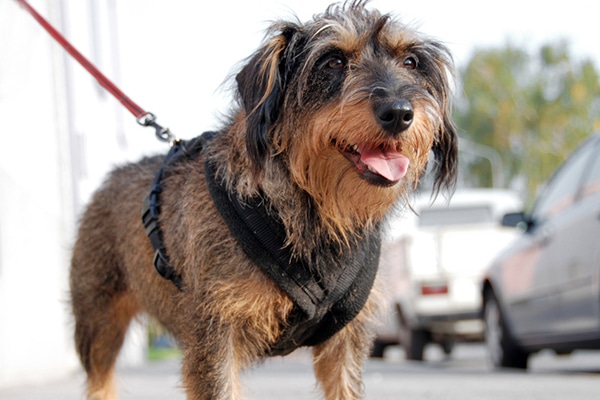Advances in veterinary medicine mean that our dogs are living longer than they used to in decades past. This is, of course, a great thing, but with old age comes aging-related diseases like dog dementia (referred to as canine cognitive dysfunction syndrome, or CDS, in the veterinary world). Canine CDS is similar to Alzheimer’s disease in people. We’re seeing more of it than ever before — simply because so many dogs are living to age 12, 14 or even older.
“Today, 25 percent of dogs aged 10 show at least one symptom of aging of the brain or canine cognitive dysfunction syndrome,” says integrative veterinarian Carol Osborne, DVM, of the Chagrin Falls Pet Clinic in Chagrin Falls, Ohio. “Interestingly, it’s more common in medium or large dogs, as opposed to small dogs.”
Signs of Dog Dementia

The signs of dog dementia are different than human dementia. Photography ©Monica Click | Thinkstock.
A senior dog with dementia isn’t going to forget his bank password or where he parked the car, but signs of CDS include disorientation or confusion, less interaction with family members and other pets, changes in behavior (stops greeting you at the door), abnormal sleep-wake cycles (sleeping all day and up all night), housetraining accidents, excessive barking or barking for no reason, becoming less active than he used to be, and anxiety.
CDS is hard to diagnose since symptoms of dog dementia can also be symptoms of other diseases like arthritis, cancer, diabetes, incontinence, kidney disease or vision or hearing loss. For instance, is your dog less interested in going for walks because of dementia or because he is suffering from joint pain from arthritis? Is he having housetraining accidents because of dementia or because he’s drinking more water and simply can’t hold it very long (which could indicate kidney disease or diabetes)? If you suspect your dog might be suffering from dementia, it’s important to see your veterinarian for a complete physical to rule out these other diseases before landing on a diagnosis of CDS.
What Can Your Dog Take for Dementia?
If your vet determines that your senior dog is suffering from canine cognitive dysfunction syndrome, don’t despair. You can do many things to help maintain or even improve his cognitive function. First, your vet might prescribe anipryl (selegiline hydrochloride), a drug that is intended to help control the signs associated with CDS.
Supplements that support brain health might also help. Talk to your veterinarian about SAMe (S-adenosyl-L-methionine) and Senilife (Ceva Animal Health), which contain a combination of brain-supporting ingredients, including ginko biloba, vitamin E and a phospholipid membrane stabilizer. Dog food manufacturers even offer foods that aim to boost brain health. Some require a prescription (available from your vet) and others are sold at pet-supply stores
How Exercise Helps Dog Dementia

Even a brisk walk can help fight dementia in dogs. Photography by angi71/Thinkstock.
A free and easy way to improve your dog’s cognitive function is exercise. “It turns out that exercise affects the dog and the human brains very similarly, positively in both cases,” Dr. Osborne explains. “Increasing physical activity can help strengthen the brain to help offset the effects of aging. Brisk walking increases the blood circulation, and oxygen and glucose can reach the brain’s tissue. A brisk walk is considered a moderate exercise, not a strenuous one, so the muscles won’t steal the extra oxygen — the brain will get that.”
To double down on the beneficial effects of exercise, change things up on your daily walks to stimulate your dog’s brain. “Make sure to visit new areas — dog parks, forests, city areas, different people’s homes — instead of walking down the exact same path every day,” Dr. Osborne advises. “Make sure your pet experiences new places on a weekly basis, including social things with other people and pets.”
On your walks, allow your dog to stop and sniff all the various smells he comes across — smelling new, interesting scents can be as stimulating to the brain as the exercise itself. Fight the urge to yank on the leash to hurry your dog along. Let him linger and enjoy this olfactory exercise.
Interactive Play Can Help Stave Off Dementia in Dogs, Too
Engage your dog in interactive activities as much as you can. Teach him new tricks, play with puzzle toys, try a low-impact dog sport like nose work or canine freestyle (also known as dancing with dogs). When it comes to the brain, the old adage “use it or lose it” applies as much to pets as it does to people. Help your dog use his brain and he will reap the benefits.
Thumbnail: Photography ©Akchamczuk | Thinkstock.
Read more about senior dogs on Dogster.com:
- 6 Things to Love About Senior Dogs
- What Inspired One Woman to Adopt an ‘Unadoptable’ Senior Dog
- How a Pet Hospice Vet Can Help Your Senior Dog
The post Understanding Dog Dementia — Signs, Treatments and How to Stave It Off appeared first on Dogster.
No comments:
Post a Comment